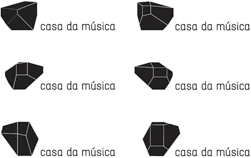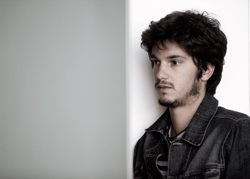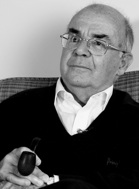|
 At two concerts of its most recent programming (November 17 and 27) the Casa da Música presented 4 premiere performances of works by Portuguese composers, all of them, in fact, commissioned by the same institution. At the first concert the Porto Symphonic Orchestra Casa da Música, conducted by Andrew Grams gave us “Non"sense%)8$messages#_! (for a nonsense reality)” by Igor C. Silva and “Imagens Sonoras” by Filipe Pires; at the second one could listen to “from underground_03” by Igor C. Silva and the Triplo Concerto Grosso by Álvaro Salazar, performed by the Remix Ensemble under the baton of Peter Rundel. At two concerts of its most recent programming (November 17 and 27) the Casa da Música presented 4 premiere performances of works by Portuguese composers, all of them, in fact, commissioned by the same institution. At the first concert the Porto Symphonic Orchestra Casa da Música, conducted by Andrew Grams gave us “Non"sense%)8$messages#_! (for a nonsense reality)” by Igor C. Silva and “Imagens Sonoras” by Filipe Pires; at the second one could listen to “from underground_03” by Igor C. Silva and the Triplo Concerto Grosso by Álvaro Salazar, performed by the Remix Ensemble under the baton of Peter Rundel.
 The scores of Igor C. Silva (born in 1989, Young Composer in Residence at the Casa da Música) made a favourable and strong impression. This young creator reveals technical finesse and a remarkable musical personality, permeated with sparks of multiform and generous surrealism. In the work for the symphonic formation, the delicate problem of balance between the orchestra and electronics is solved in an excellent way, by means of a writing, in which the interplay of sonorities is realized with the ease and mastery of a born orchestrator (or if you prefer, synthesizer). Yet, do not think that the illusionistic fusion is the only register, on which the work is based, since Silva does not fear the programmatic. The initial gesture is an intervention of an acousmatic narrator, who proclaims, “You are losing your mind”, giving out phrases/sonorities, which cross the musical continuum with different levels of perceptibility. There are often smartly blurred, yet more defined musical gestures incrusted in the discourse, which culminate in a notable moment: the solo of amplified violoncello, which is the only occasion when this device is used in the instruments. The scores of Igor C. Silva (born in 1989, Young Composer in Residence at the Casa da Música) made a favourable and strong impression. This young creator reveals technical finesse and a remarkable musical personality, permeated with sparks of multiform and generous surrealism. In the work for the symphonic formation, the delicate problem of balance between the orchestra and electronics is solved in an excellent way, by means of a writing, in which the interplay of sonorities is realized with the ease and mastery of a born orchestrator (or if you prefer, synthesizer). Yet, do not think that the illusionistic fusion is the only register, on which the work is based, since Silva does not fear the programmatic. The initial gesture is an intervention of an acousmatic narrator, who proclaims, “You are losing your mind”, giving out phrases/sonorities, which cross the musical continuum with different levels of perceptibility. There are often smartly blurred, yet more defined musical gestures incrusted in the discourse, which culminate in a notable moment: the solo of amplified violoncello, which is the only occasion when this device is used in the instruments.
In the work for the Remix Ensemble one can spot the same personality, but without any repetition of recipes. The score is divided, more clearly in different sections and, according to the author himself, it reflects the taste for a wide range of musical genres. This, perhaps, causes the apparition of some less subtle instrumental gestures (a somewhat primary rhythm and tutti at the octave) requiring, possibly, a certain refinement. One should understand this term in the sense of a certain digestion of influences and experiences, and not within any restrictions of this most welcome gestural variety. In any case it should be emphasized that we are dealing with a career deserving to be followed with attention and empathy.
The performance of works by Filipe Pires (born in 1934) and Álvaro Salazar (born in 1938), within a distance of a couple of days, draws attention to a generation, which became fundamental in breaking the academic ties of retrograde education towards a series of modern developments in the musical art, either the Second Viennese School or the sound revolutions of post-45. It is worth contemplating the different works of this generation, which also includes other names such as Cândido Lima and culminates in the already departed Jorge Peixinho and Emmanuel Nunes. It allows noticing the origin of problems and temptations, which do not fail to illuminate some tendencies of the present, already accurately denominated as the “second Renaissance of composition in Portugal”.
 Filipe Pires has always proclaimed the liberty in using a variety of styles, from his first neoclassical loves to electroacoustic music and open forms. These “Sound Images” (“Imagens Sonoras”) constitute a transcription of the piece for piano, entitled “Estudos de Sonoridades” (“Studies on Sonorities”). Let me claim, that despite the past of a solid piano formation the composer’s choice medium is the orchestra. Like in every good transcription, this one constitutes a perfectly satisfying autonomous piece and one never feels remains of the original pianism. Filipe Pires has always been an excellent orchestrator and, it should be said that he has always known how to transmit to his pupils this sense of refined employment of symphonic orchestra. The somewhat redundant neoclassical language of the original, gains with the instrumental treatment, which although following accurately the plot of the piano piece, achieves, through the intelligent distribution of the instrumental groups, an interesting effect of distancing and increased drama. However, it is important to raise the question of the already referred digestion of influences and of creative freedom: this subject reappears nowadays when many authors, often with less technical competence and cultural world-knowledge, indulge with childish delight in overestimating the aesthetic pertinence of thinly disguised school exercises. The work of Pires presents seriousness and excellent craftsmanship, but raises questions, which widely transcend his compositional practice. Filipe Pires has always proclaimed the liberty in using a variety of styles, from his first neoclassical loves to electroacoustic music and open forms. These “Sound Images” (“Imagens Sonoras”) constitute a transcription of the piece for piano, entitled “Estudos de Sonoridades” (“Studies on Sonorities”). Let me claim, that despite the past of a solid piano formation the composer’s choice medium is the orchestra. Like in every good transcription, this one constitutes a perfectly satisfying autonomous piece and one never feels remains of the original pianism. Filipe Pires has always been an excellent orchestrator and, it should be said that he has always known how to transmit to his pupils this sense of refined employment of symphonic orchestra. The somewhat redundant neoclassical language of the original, gains with the instrumental treatment, which although following accurately the plot of the piano piece, achieves, through the intelligent distribution of the instrumental groups, an interesting effect of distancing and increased drama. However, it is important to raise the question of the already referred digestion of influences and of creative freedom: this subject reappears nowadays when many authors, often with less technical competence and cultural world-knowledge, indulge with childish delight in overestimating the aesthetic pertinence of thinly disguised school exercises. The work of Pires presents seriousness and excellent craftsmanship, but raises questions, which widely transcend his compositional practice.
 The artistic ethics and the work of Álvaro Salazar are located on the antipodes of this competent pragmatism. At a ceremony, which anticipated the concert on November 27, the composer was awarded with the Honorary Medal of the Portuguese Author’s Society; this tribute gave the musician the opportunity to explain his artistic credo. Yet, his work spoke better than the words, indeed notable through the pertinence and sense of humour. This magnificent Triplo Concerto Grosso, confirms, on the one hand, Salazar as one of our great active composers, and on the other, reveals one more side of a coherent and varied style – at a more direct level, the extraordinary instrumental invention, in which silence and sound, sound and “noise” merge and penetrate each other in a magical way. Going further in this attempt of describing verbally such a poetics anchored in sound, it is worth emphasizing the sense of mystery of the various layers to be read (the palimpsest so dear to the author), in a music which (even if ironically desired to be uncommunicative) awakens, surprises and honours the intelligence and sensibility of the one enjoying it. The artistic ethics and the work of Álvaro Salazar are located on the antipodes of this competent pragmatism. At a ceremony, which anticipated the concert on November 27, the composer was awarded with the Honorary Medal of the Portuguese Author’s Society; this tribute gave the musician the opportunity to explain his artistic credo. Yet, his work spoke better than the words, indeed notable through the pertinence and sense of humour. This magnificent Triplo Concerto Grosso, confirms, on the one hand, Salazar as one of our great active composers, and on the other, reveals one more side of a coherent and varied style – at a more direct level, the extraordinary instrumental invention, in which silence and sound, sound and “noise” merge and penetrate each other in a magical way. Going further in this attempt of describing verbally such a poetics anchored in sound, it is worth emphasizing the sense of mystery of the various layers to be read (the palimpsest so dear to the author), in a music which (even if ironically desired to be uncommunicative) awakens, surprises and honours the intelligence and sensibility of the one enjoying it.
A modern musical prose in which one has the sensation that the music is born at the very moment, in which it is performed, but without the slightest impression of a noxious improvisation. The instrumental groups alternate between each other, in an unsystematic way, the functions of concertino and ripieno, tending the whole towards a surprising cadenza of violoncello, which, indeed, was brilliantly executed by Oliver Parr. A great work, which had a warm reception by the public.
And since we came to mention one of the performers, we could not fail to refer the great interpretative quality of both concerts. Andrew Grams conducted Igor C. Silva and Filipe Pires with the same rigour and musicality, with which he offered us a notable version of the Symphony in Three Movements by Stravinsky. Peter Rundel, particularly in the work of Álvaro Salazar, apprehended profoundly the thread of the musical discourse, never letting us feel the seams between the measured writing and the local liberties.
|
 At two concerts of its most recent programming (November 17 and 27) the Casa da Música presented 4 premiere performances of works by Portuguese composers, all of them, in fact, commissioned by the same institution. At the first concert the Porto Symphonic Orchestra Casa da Música, conducted by Andrew Grams gave us “Non"sense%)8$messages#_! (for a nonsense reality)” by Igor C. Silva and
At two concerts of its most recent programming (November 17 and 27) the Casa da Música presented 4 premiere performances of works by Portuguese composers, all of them, in fact, commissioned by the same institution. At the first concert the Porto Symphonic Orchestra Casa da Música, conducted by Andrew Grams gave us “Non"sense%)8$messages#_! (for a nonsense reality)” by Igor C. Silva and  The scores of Igor C. Silva (born in 1989, Young Composer in Residence at the Casa da Música) made a favourable and strong impression. This young creator reveals technical finesse and a remarkable musical personality, permeated with sparks of multiform and generous surrealism. In the work for the symphonic formation, the delicate problem of balance between the orchestra and electronics is solved in an excellent way, by means of a writing, in which the interplay of sonorities is realized with the ease and mastery of a born orchestrator (or if you prefer, synthesizer). Yet, do not think that the illusionistic fusion is the only register, on which the work is based, since Silva does not fear the programmatic. The initial gesture is an intervention of an acousmatic narrator, who proclaims, “You are losing your mind”, giving out phrases/sonorities, which cross the musical continuum with different levels of perceptibility. There are often smartly blurred, yet more defined musical gestures incrusted in the discourse, which culminate in a notable moment: the solo of amplified violoncello, which is the only occasion when this device is used in the instruments.
The scores of Igor C. Silva (born in 1989, Young Composer in Residence at the Casa da Música) made a favourable and strong impression. This young creator reveals technical finesse and a remarkable musical personality, permeated with sparks of multiform and generous surrealism. In the work for the symphonic formation, the delicate problem of balance between the orchestra and electronics is solved in an excellent way, by means of a writing, in which the interplay of sonorities is realized with the ease and mastery of a born orchestrator (or if you prefer, synthesizer). Yet, do not think that the illusionistic fusion is the only register, on which the work is based, since Silva does not fear the programmatic. The initial gesture is an intervention of an acousmatic narrator, who proclaims, “You are losing your mind”, giving out phrases/sonorities, which cross the musical continuum with different levels of perceptibility. There are often smartly blurred, yet more defined musical gestures incrusted in the discourse, which culminate in a notable moment: the solo of amplified violoncello, which is the only occasion when this device is used in the instruments. Filipe Pires has always proclaimed the liberty in using a variety of styles, from his first neoclassical loves to electroacoustic music and open forms. These “Sound Images” (“Imagens Sonoras”) constitute a transcription of the piece for piano, entitled “Estudos de Sonoridades” (“Studies on Sonorities”). Let me claim, that despite the past of a solid piano formation the composer’s choice medium is the orchestra. Like in every good transcription, this one constitutes a perfectly satisfying autonomous piece and one never feels remains of the original pianism. Filipe Pires has always been an excellent orchestrator and, it should be said that he has always known how to transmit to his pupils this sense of refined employment of symphonic orchestra. The somewhat redundant neoclassical language of the original, gains with the instrumental treatment, which although following accurately the plot of the piano piece, achieves, through the intelligent distribution of the instrumental groups, an interesting effect of distancing and increased drama. However, it is important to raise the question of the already referred digestion of influences and of creative freedom: this subject reappears nowadays when many authors, often with less technical competence and cultural world-knowledge, indulge with childish delight in overestimating the aesthetic pertinence of thinly disguised school exercises. The work of Pires presents seriousness and excellent craftsmanship, but raises questions, which widely transcend his compositional practice.
Filipe Pires has always proclaimed the liberty in using a variety of styles, from his first neoclassical loves to electroacoustic music and open forms. These “Sound Images” (“Imagens Sonoras”) constitute a transcription of the piece for piano, entitled “Estudos de Sonoridades” (“Studies on Sonorities”). Let me claim, that despite the past of a solid piano formation the composer’s choice medium is the orchestra. Like in every good transcription, this one constitutes a perfectly satisfying autonomous piece and one never feels remains of the original pianism. Filipe Pires has always been an excellent orchestrator and, it should be said that he has always known how to transmit to his pupils this sense of refined employment of symphonic orchestra. The somewhat redundant neoclassical language of the original, gains with the instrumental treatment, which although following accurately the plot of the piano piece, achieves, through the intelligent distribution of the instrumental groups, an interesting effect of distancing and increased drama. However, it is important to raise the question of the already referred digestion of influences and of creative freedom: this subject reappears nowadays when many authors, often with less technical competence and cultural world-knowledge, indulge with childish delight in overestimating the aesthetic pertinence of thinly disguised school exercises. The work of Pires presents seriousness and excellent craftsmanship, but raises questions, which widely transcend his compositional practice. The artistic ethics and the work of Álvaro Salazar are located on the antipodes of this competent pragmatism. At a ceremony, which anticipated the concert on November 27, the composer was awarded with the Honorary Medal of the Portuguese Author’s Society; this tribute gave the musician the opportunity to explain his artistic credo. Yet, his work spoke better than the words, indeed notable through the pertinence and sense of humour. This magnificent Triplo Concerto Grosso, confirms, on the one hand, Salazar as one of our great active composers, and on the other, reveals one more side of a coherent and varied style – at a more direct level, the extraordinary instrumental invention, in which silence and sound, sound and “noise” merge and penetrate each other in a magical way. Going further in this attempt of describing verbally such a poetics anchored in sound, it is worth emphasizing the sense of mystery of the various layers to be read (the palimpsest so dear to the author), in a music which (even if ironically desired to be uncommunicative) awakens, surprises and honours the intelligence and sensibility of the one enjoying it.
The artistic ethics and the work of Álvaro Salazar are located on the antipodes of this competent pragmatism. At a ceremony, which anticipated the concert on November 27, the composer was awarded with the Honorary Medal of the Portuguese Author’s Society; this tribute gave the musician the opportunity to explain his artistic credo. Yet, his work spoke better than the words, indeed notable through the pertinence and sense of humour. This magnificent Triplo Concerto Grosso, confirms, on the one hand, Salazar as one of our great active composers, and on the other, reveals one more side of a coherent and varied style – at a more direct level, the extraordinary instrumental invention, in which silence and sound, sound and “noise” merge and penetrate each other in a magical way. Going further in this attempt of describing verbally such a poetics anchored in sound, it is worth emphasizing the sense of mystery of the various layers to be read (the palimpsest so dear to the author), in a music which (even if ironically desired to be uncommunicative) awakens, surprises and honours the intelligence and sensibility of the one enjoying it.